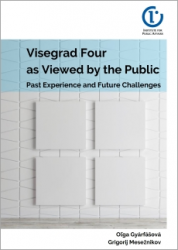
Fri 19 April 2024
Warszawa (PL)
9/0°C
| Thu | Fri | Sat | Sun | Mon |
|---|---|---|---|---|
| 8 | 10 | 9 | 6 | 9 |
Fri 19 April 2024
Praha (CZ)
8/2°C
| Thu | Fri | Sat | Sun | Mon |
|---|---|---|---|---|
| 11 | 9 | 7 | 9 | 9 |
Fri 19 April 2024
Bratislava (SK)
12/3°C
| Thu | Fri | Sat | Sun | Mon |
|---|---|---|---|---|
| 12 | 11 | 11 | 10 | 10 |
Fri 19 April 2024
Budapest (HU)
13/2°C
| Thu | Fri | Sat | Sun | Mon |
|---|---|---|---|---|
| 14 | 14 | 13 | 12 | 12 |
The Warsaw Tango
by Maria Lipnicka
Sauntering along the streets of Warsaw's Praga district, you will not encounter a street busker, nor will you hear the sound of a wailing violin or the tones of a groaning accordion. It is only now and then that in the vicinity a song is audible, abashed by solitude and muffled by the din of a haggling crowd at the Różycki Praga bazaar. Apparently, therefore, there is no music or art among the old tenement houses. However, what happens not infrequently is that the appearances perceived by a cursory spectator may be misleading. For Warsaw not only unfolds its song, but also dances to its rhythm.
A tango is commonly associated with Argentina and the quick temper attributed to the inhabitants of Latin America - how absurd, then, the statement seems to be, asserting that the Central European capital, with its fickle climate and immutable temperament, has been drawn into the fervour of Latin American passions! Perhaps I shall mitigate that impression of an absence of logic with an assurance that this claim is purely empirical and metaphorical in its nature. For I dare not declare that on Warsaw's pavements you will find traces of tango's fiery steps, because that would be utterly false, as Warsaw does not dance, be it in the physical way or ultimately in any tangible one. Warsaw performs a mental dance of decline and ascent, accompanying the ubiquitous energy of Eros. Absurd again? Please, do not be misled by false appearances.
The Greek term "Eros" is nowadays associated with somewhat shallow notions bordering on the realm of sexual seduction. And yet, the creators of that term intended to imply an instinct, an urge bringing us out of chaos, the world's only driving force, or even the power that created it - "Eros, the god of love, emerged to create the Earth. Prior to that, everywhere there was stillness, nakedness, inertia. Now there is life, joy, and motion." What's more, according to Plato, "Eros" describes an energy constantly accompanying humanity, both in misery and in abundance. It is the motive power of progress and a source of yearning for beauty, for something richer and fuller. And it is just the philosophy behind the Greek concept that the tango represents - that thought was expressed in his lecture entitled "The Philosophy of the Tango" by Andreas Fornefett, who emphasized the fact that the analogy between a tango and philosophy lies in that they follow "Eros", the desire for a transformation of physicality into a spiritual experience, for an escape from daily existence. From the daily existence of Warsaw's poverty and loneliness.
The Argentinian tango, most extensively examined by Andreas Fornefett, was born at a time of extreme desolation and frustration among men coming to South America. Those men, deprived of their homeland, the tenderness of women, the warmth of a family, performed, in male company, a dance in which they tried to convey just that pent-up longing and intensity seeking release. The motto of a tango is to reveal the pain, the inner discord. Despite the fact that the origin of the tango lay in class distinctions, poverty and the isolation of the destitute, that dance and music art had not turned into a protest or the beginning of a revolution. The dancers even appear to scratch wounds. This is why the dance is so fascinating and ravishing - it embodies the 20th-century existentialism, evoking especially the philosophy of Albert Camus from his "The Plague", in which both Dr. Rieux and Father Paneloux discover the inevitability of human suffering and learn to accept it. The tango acknowledges that harrowing feature of human existence and even additionally exposes to our eyes the ambiguity of joy and distress - that idea was best expressed by Antoine de Saint-Exupery with the words: "What creates your deepest suffering is, at the same time, a source of your greatest joy." And that attitude may permeate one's being not only in Argentina. I have learnt that extraordinary acceptance and love towards the world just from my city.
The Warsaw tango has its own history and its own dancers, as well as a symbolic stage, namely the Warsaw Szmulki place which is inspiring to me, the information plates calling it Szmulowizna. It is here that the opposites of all Warsaw clash with one another: the past and the present, misery and wealth, flowering and decay, the sacred and the profane. Meeting so many issues in one area may jeopardise my work with disruption, so I will anticipate that, if possible in any way, and attempt to arrange those symbolic dances according to the planes on which their rhythms are tapped.
The social differences in Warsaw are visible to the naked eye, especially for arrivals travelling by railway - Poland's capital will welcome them with the crumbling Central Station, which is regarded by a permanent resident as synonymous with homelessness, begging, and social degradation. Yet, if a guest refuses to be deterred by this underground, drab landscape, then right upon leaving the concrete structure, that patience of his will be rewarded by the sight of a masterpiece of the contemporary Polish architecture - one of Warsaw's biggest shopping malls called "Złote Tarasy" (The Golden Terraces). A similar situation, only not on the example of architecture, but rather on that of people themselves, takes place at the Szmulki site, where we find numerous, impoverished, and frequently also pathological families living next door to increasingly higher-earning representatives of the middle class. And here the spirit of the tango continues to roam, since poverty keeps throbbing here, crawling from under the peeling plaster, giggling with the voice of a child, smothering the weeping with the rhythm of techno music, and encountering wealth, not only a material one, but also spiritual. Somewhere side by side, even in some passionate tension, they abide near one another - the poor eagerly yearning after possessions and opportunities, while those who are richer drawing inspiration from the lives of simple people and missing a world fraught with lesser ambitions. And here we slowly pass on to the Warsaw cultural contrasts.
The "Eros" of artistry and human expression is definitely gaining momentum and changing the face of Warsaw in an exceedingly innovative way. Theatre, literature, and music which represented a high level of performance have tended, until recently, to be locked away in massive buildings resembling strongholds. Szmulowizna has broken loose from this convention and found a new location - factories. The "Fabryka Trzciny" Artistic Centre and the "Wytwórnia" Theatre were formed here - venues located in old manufacturing structures where meetings take place, involving original people responsive to the surrounding world and the slightly ever-terrifying reality. The Szmulki area has, therefore, become a crossroads of many paths traversed by advocates of diverse ideas. Here, in the space of almost one street, we shall meet several different "Eros" influences - the best example appears to be the emblematic intersection of Kawęczynska Street and Podlaska Street, where various philosophies and "cultures" meet. Different cultures - highbrow culture on behalf of which the progressive Nowa Praga Theatre (the aforesaid "Fabryka Trzciny" Artistic Centre) manifests its presence in this representative space, and the lowbrow culture portrayed by Dorota Masłowska in her grotesque novel "Paw Królowej" (The Queen's Peacock), presented as a domain of dwellers from neglected housing estates who perpetually slide into an ever lower condition. Different philosophies of life - Bazylika Najświętszego Serca Jezusowego (the Basilica of the Lord Jesus Holiest Heart), which inspires respect with its classical beauty and immense size, forms a background for the events of the modern world of the young who espouse entirely new values of independence or even nihilism and increasingly stifle their existential angst by playing repetitive music and drinking.
The most distinctive and captivating dance in Warsaw is performed by history and the present incessantly engaged in mutual flirtation. The rhythm can already be sensed when peering closer at Szmulki's architectural scheme. The walker is confronted by rising prewar-built brick tenements and their younger neighbours - concrete houses dating back to the times of the People's Republic, whose state of collapse hardly differs from the plight of the prewar buildings. However, this district is not a ghetto - the present day has been brought into the midst of the history's witnesses, namely state-of-the-art housing developments flaunting PVC windows as well as red-roofed houses gleaming with their almost palpable freshness, ostensibly springing up from under the ground like a mirage on a desert. Here, the very name of the neighbourhood, "Szmulki", bestowed to commemorate Szmul Zbytkower, the founder of a Jewish settlement, performs a mournful dance with historical remembrance and anti-Semitic slogans on the walls. Crumbling bricks appear to struggle with decay and earnestly to remind one that creation and life once flourished just here. Fortunately, the prewar and interwar buildings are gaining more and more admirers - the best example illustrating this can be the website www.szmulowizna.pl, on which web surfers fondly examine biographies of fractured native houses. A life-instilling wind of history blows from the bare ruins - the past events devastated Warsaw, but as a result of that they have become an inseparable part of the city whose soil is saturated with struggle, blood, and rubble. Death and decay turn into a new life here, a source of strength for the conscious young.
Whereas there have remained extremely few material monuments of Warsaw from before the wars, the postwar history of socialist realism imprinted on her shape its heavy stamp. The anguish of another occupation, of the absence of freedom and the manipulation of the masses, has become a part of the capital city's air. The city's architecture has been ruled, till this day, by Stalin's testament - Pałac Kultury i Nauki (the Palace of Culture and Science), which seems to be Warsaw's true centre, its focal point. The concrete housing estates, the dreary supermarkets, and the milk bars adored by some inhabitants, will not allow one to forget the years of the People's Republic. However, for a dozen or so years now, that mindset has been drawn into flirting play with consumerism which gradually allures the dairymaid and I will venture a claim that it has already by now converted her into a slim "businesswoman". Temptation, enticement, these are adequate words, because the American McDonalds or Coca-Cola, promoting a new lifestyle, have not invaded the place by force of arms, as they have just imperceptibly insinuated themselves through dance. And, for the time being, those two cultures flagellate each other as ones each wielding their own influence, yet both knowing their respective places - the People's Republic of Poland belonging to the past, while the supermarkets, to the future. Yesterday and Tomorrow seem, therefore, to enjoy this union in Today, while the tension between them joins the energy of the Warsaw tango.
Perhaps my attempts at metaphorically representing my intimate comprehension of Warsaw's passionate power, which I have undertaken in this essay, do not fully reflect that feeling of being merged with the city. Maybe by merely living here, watching the people attentively and ardently, inhaling daily the Warsaw air, one can understand the way in which the peculiar forces and worlds clash with one another here, share a common nexus in time, coalesce and tap each other's vigour for living in a big city. However, maybe in a place of so refreshing an ambience, too, the one which the aforementioned "Fabryka Trzciny" Artistic Centre has become for me, one ought to lend one's ear to the sounds of Ástor Piazzolla's unique "Libertango" in order to comprehend the strong presence of tango in the streets of Warsaw. Its fierce rhythm will be suddenly evoked by the beat of tapping heels executed by a Warsaw man chasing after his good fortune, the whine of a cello will articulate the pain and the solitude, while the twangs of a droning double bass will aptly render reconciliation and fusion.
I hope that my words do not sound naïve, but I wish to portray Warsaw as seen with the eyes of a young person who wants to believe and does believe in a positive image of her beloved city. I am trying not to idealise my little homeland in the way that romantic inspired poets did, for similarly to a dear person she deserves to be treated with candour. I want to expose imperfection not so much to immerse myself in boundless criticism, but rather in order to discover in her imperfection an element of humanity and timeless beauty. I want to exonerate the social injustice prevailing in the city and its cultural disparities by invoking just the energy of human erring which I find also in the tango. I want my city to dance and not to rush headlong plunging into chaos. I want the young people who feel the way I do to set Warsaw, with their vision, surrendering to a dance of sincerity and an acceptance of the world. Many people claim that one must not be resigned to reality, that one must combat the problems of modernity, but in my opinion the mere naming and accepting of the limits of human potential will allow our little world to be at least partially rectified. I want us, the inhabitants of not only Warsaw but also of other towns and villages, not to be afraid, in the spirit of dauntless dance and not-so-timid philosophies, to indicate the wounds and the ills, and in those of them which we cannot change, to recover the splendour of human existence. Thus, I join Marcus Aurelius' words of prayer: "God, give me patience so that I would accept what I cannot change. Give me strength so that I would change what I can change. And give me wisdom so that I would be able to differentiate one from the other." And this is just what I wish to all Warsaw's citizens.







